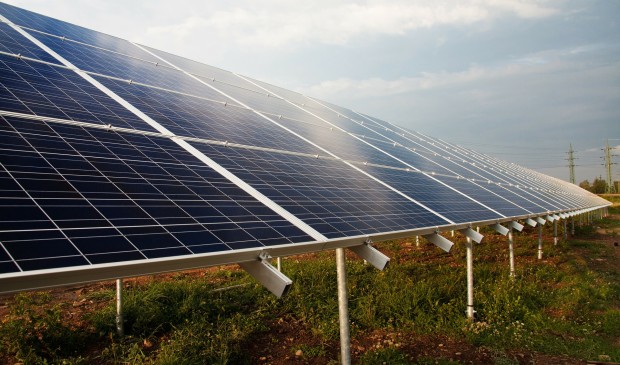Full-scale solar option remains on table
Friday, September 25, 2015 by
Tyler Whitson In spite of a lengthy debate about how much solar capacity the city should contract into next month, the City Council Austin Energy Utility Oversight Committee did not appear to rule out any options at its meeting on Thursday.
The course that the discussion followed was similar to the one that has taken place over the past several weeks, with solar advocates imploring Council to consider committing to 600 megawatts’ worth of contracts before they expire toward the end of next month and Austin Energy staff arguing for a 200 to 300 MW purchase, with more to follow in the coming years.
Austin Energy staff, however, provided some new projections — and some new arguments — as to how it thinks the two scenarios might play out.
“Keep in mind today, as policymakers, that what you’re really making a policy decision on isn’t how much, it’s how much risk,” said Austin Energy General Manager Larry Weis. “Our ratepayers are the ones that have to bear the risk.”
Austin Energy is currently sitting on over 150 proposals from solar contractors that it received earlier this year. Some of those bids fall under $40 per megawatt hour, which is far cheaper than any solar offers the utility has received in the past.
The utility released the request for proposals as part of the city’s adopted Austin Energy Resource, Generation and Climate Protection Plan to 2025, which states that Austin Energy “will contract for up to (600 MW of utility-scale solar energy) by 2017, if available and affordable.”
Solar advocates have argued that Austin Energy may not see such low prices again for years, as the federal solar Investment Tax Credit that many believe is artificially lowering prices will drop from 30 to 10 percent for projects that are not online by the end of next year.
Council Member Leslie Pool reiterated that point. “If we delay, or slow down, there’s the chance that that price cut or discount may go away,” she said. “We know it’s going away at the end of next year.”
Throwing his proverbial chips on the table, Weis responded that he personally believes the U.S. Congress will extend the tax credit beyond 2016.
“There’s such a push with the Clean Power Plan for the (Obama) administration, and the solar industry is huge, and it’s a huge lobby and everything,” Weis said. “My personal expectation is … there will continue to be tax incentives for developing more renewable energy. I just don’t see how they could just stop it.”
The Clean Power Plan, which the Environmental Protection Agency finalized in August, sets individualized targets for states to substantially cut carbon emissions by 2030.
Khalil Shalabi, Austin Energy’s vice president of energy market operations and resource planning, has also argued that, even if the credit expires, the reduction will likely have only a temporary impact and solar prices will continue to drop beyond current prices thereafter.
Based on current projections, Shalabi said he believes that entering into all 600 MW solar energy contracts next month would have a substantially greater impact on customer bills than the 200 to 300 MW proposal the utility plans to lay out at the next Council meeting on Thursday.
Shalabi said that the projected impact of the more modest plan in 2017 — using 250 MW as a reference point — would be about $3 per year on the average residential customer bill while the more aggressive plan would cost the average residential customer about $15 per year.
Austin Energy projects that purchasing 600 MW of solar contracts by 2017 would cost the utility more than $16 million, Shalabi added, while purchasing 300 MW in contracts by 2017 and constructing and owning the remaining 300 MW between 2020 and 2025 would generate almost $19 million in revenue.
Responding to Pool’s questions about why the impact is so much higher, Shalabi argued that there are two reasons. “The range is over more and more years because they would come on a little bit later and also because we start digging into more expensive contracts,” he said.
Not all of the bids are at the same price, Shalabi explained, and the city would have to enter into some of the more expensive contracts to reach the full 600 MW.
Former Electric Utility Commissioner Joep Meijer argued that investing in 600 MW would reduce rates. “If you do that at such a scale, what will happen? Rates will go down, it’s that simple,” he said. “My calculations show that for every 100 MW of solar that you put online, you’ll see a reduction in the use of (natural) gas units to a total savings of at least $10 million a year.”
While it wants Council to consider 600 MW of solar investments as soon as possible, the Electric Utility Commission voted on Monday to recommend that Council go ahead and approve Austin Energy’s 200 to 300 MW proposal on Thursday.
Shalabi later told the Austin Monitor that all of the contracts included in Austin Energy’s 200 to 300 MW proposal should come online by the end of next year and therefore would benefit from the tax credit. “Our expectation is that this initial tranche is (investment tax credit)-driven and would be built by the end of 2016,” he said.
Although the committee did not take a vote, members and staff appeared to reach a mutual understanding that Council still has the opportunity to consider all 600 megawatts before the current contract bids expire.
You're a community leader
And we’re honored you look to us for serious, in-depth news. You know a strong community needs local and dedicated watchdog reporting. We’re here for you and that won’t change. Now will you take the powerful next step and support our nonprofit news organization?










